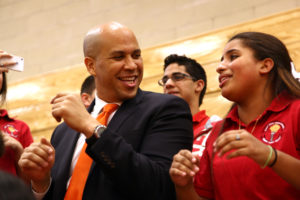The difference is monumental, no matter how it is measured. Those needs go beyond educational needs, they include food, clothing, and shelter, and extend to lack of close family and community ties and support and lack of helpful role models. They include the needs that arise from a life led in an environment of violence, poverty, and despair. Urban youth are often isolated from the mainstream of society. Education forms only a small part of their home life, sometimes no part of their school life, and the dropout rate is almost the norm. The goal is to motivate them, to wipe out their disadvantages as much as a school district can, and to give them an educational opportunity that will enable them to use their innate ability.
Abbott v. Burke IV, May 14, 1997
The legislative and executive branches of government have enacted a funding formula that is designed to achieve a through and efficient education for every child, regardless of where he or she lives. On the basis of the record before us, we conclude that SFRA is a constitutionally adequate scheme. There is no absolute guarantee that SFRA will achieve the results desired by all. The political branches of government, however, are entitled to take reasoned steps, even if the outcome cannot be assured, to address the pressing social, economic, and educational challenges confronting our state. They should not be locked in a constitutional straightjacket. SFRA deserves the chance to prove in practice that, as designed, it satisfies the requirements of our constitution.
Abbott v. Burke, April 28, 2009
Irving Kristol famously quipped that a neoconservative was a liberal who had been mugged by reality. That definition is also a good way to describe the Supreme Court’s decision yesterday on the constitutionality of the School Funding Reform Act. Hailed by the Star-Ledger as a “stunning shift,” the decision (see here for complete text) overturns our long reliance on the designation of 31 special-needs districts in favor of a funding formula that allots extra school aid based on individual children. For those interested in local coverage, the Trenton Times emphasizes the ruling as a political victory for Democrats and Corzine;, The Record focuses on some of the historical misuse of the Abbott money and the stigma attached; The Press of Atlantic City quotes some unhappy Abbott administrators who fear the worst from a lower level of funding; the New York Times presents the Court’s decision as fair and balanced; New Jersey Newsroom cites the Court’s caveat that “There is no absolute guarantee that (the funding plan) will achieve the results desired by all;”Columnist Bob Braun calls it a “an almost whimpering concession that the state should be allowed to try to do the best it can.”
The original Abbott decisions were marked by sweeping outrage at the inequity of New Jersey’s public education system due to funding based on local property taxes. We must right the wrongs engendered by poverty and prejudice regardless of cost, bellowed the Justices, with a fervor linked to the sins of segregation. Yesterday’s decision, however, is infused with economic concerns as the cost of a nobly-intentioned educational system highjacks the State’s solvency: “These efforts [to ensure that S.F.R.A. is fair] are all the more impressive due to the coordinated branches’ collective will to do so during difficult economic times when there is scarce state resources.” Justice Jaynee LaVecchia, who wrote the decision, painstakingly outlines in a footnote that the richest districts in N.J. spent $14,046 per child this year, Abbott districts spent $17,325 per child, and the average cost in the U.S. this year was $9,154. She also remarks that the Court “cannot ignore the State’s estimation that the Abbott districts will receive cumulatively over the next two years approximately $630 million in Federal funds.”
Bleeding hearts cauterized by an economic recession? 1970’s flower children wizened by exposure to corruption? Depending upon whom you ask, New Jersey has either grown up or given up.
This intrusion of reality into what is, in essence, a philosophical and ethical issue, is not a bad thing. The facts are unavoidable: Abbott didn’t work. New Jersey cannot sustain its current level of spending on education.
The Education Law Center issued a press release yesterday mourning the decision, charging that “the SFRA is a major setback in the quest for educational equity for all New Jersey school children,” and vowing to fight on. The ELC also makes the salient point that the backbone of SFRA – that the State would provide all the Abbott services to poor kids regardless of where they live – has already been undermined by Corzine’s inability to swing the cash for full-day preschools for poor kids.
Here’s the problem: unless we find more efficient ways to deliver educational services to our kids, we still won’t be able afford the pricetag. Our current infrastructure, dominated by home rule gone mad (616 school districts!) — is unsustainable. ELC is right: we can’t afford to run full-day preschools in hundreds of school districts. What if we only ran one in each of our 21 counties? Wouldn’t that be a step toward an efficient and fair education system for Jersey kids?
If New Jerseyans are committed to equitable educational opportunities, then we need to be willing to look beyond our quaint little suburban idylls and think a bit more globally — or at least within our own county.



